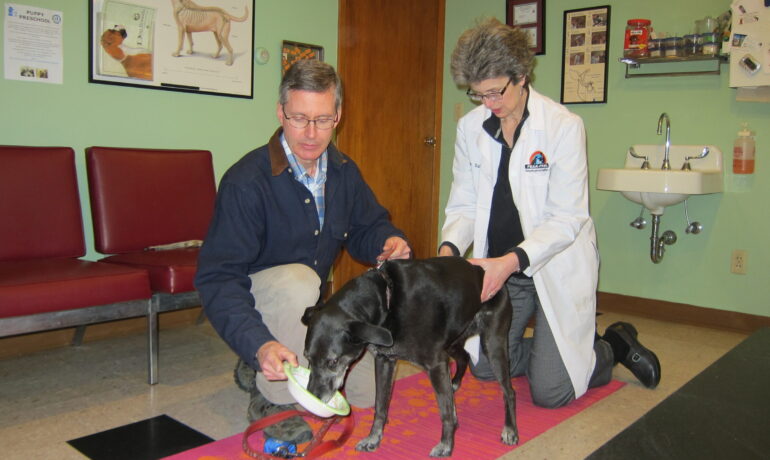Senior pet Care guidelines with an Eye for behavior
The American Animal Hospital Association (AAHA) has recently published senior care guidelines for dogs and cats for veterinarians to follow. This white paper is a guide to the three ways to provide integrative care, schedule appointments with enough time and resources and how to promote what we offer. A break down the guidelines, with an eye for senior pet behavior follows:
Integrative care – Senior care is integrative, blending medical intervention, behavior management, coexisting condition consideration, and environmental modification. Most veterinarians are well versed in diagnosing senior medical conditions and therapy options. Management of multiple medical problems in one pet requires a bit more nuance in knowledge. Considering changes in anxiety, aggression, or compulsive behavior due to brain aging or physical changes is not always easy. Few veterinarians have been taught how to consider a rise behavior problem relates to an aging pet’s physical health. We rarely ask to see or describe the home to consider how this aging pet must function in this home to maintain housetraining, sleep, or play. That thirteen-year-old Golden Retriever may need to walk down a flight of hardwood stairs to get outside – a bit more difficult now than when he was three years old.
How do you screen for senior pet behavior changes? Ask open ended, lighthearted questions. Do not ask if anxiety, aggression, or compulsion problems are arising – these words sound negative, and many people will say no although the pet may be showing these changes. Ask “Is your pet doing anything off or that drives you a little crazy?” This is when clients will say “No – just the usual growling at the kids or being spiteful by urinating by the door before I let him out” Listen to these answers – they are telling you there is a change. Often pain/ inflammation triggers aggression. Changes in kidney function or cognition cause breaks in housetraining. A simple urinalysis can determine many brewing problems. It is easy to watch the dog walk out the door and around the parking lot for a gait exam. Often you will find a brewing health problem you can address. Make suggestions to manage the behavior changes in the home with runners over hardwood flooring, low entry litter boxes, or pheromones to decrease anxiety.
Here are a couple of senior pet cases from my experience to bring this point home. Case number one is a senior German Shepherd growling at the children, and Case number two is a senior indoor/outdoor cat urinating on the bathroom rug and in the litter box. At each exam, I asked “what is driving you crazy about your pet” question. The owner of the senior dog replied “He is growling a bit as the kids run past him in the hallway. “The kids were 3 and 5 years old. I advised ways to separate the dog when the kids were active, then noted the upper fourth premolar was inflamed. We set up a dental where the infected tooth was removed. I called to see how the dog was doing a few days later. The client said he was eating well, more active and had stopped growling at the kids. The painful tooth was causing the early aggression towards the children.
In the second case, I suggested running baseline blood work to check the liver, kidney and blood sugar levels and a urine check. This big, purring, happy cat had not lost any weight, did not seem to have any discomfort, and was happily purring as we examined him. His blood test showed his glucose was over 500. He was diabetic. He was not “onery” urinating on the bathmat as the client thought. He had increased urine volume that he would put on the mat. We started insulin and diet changes immediately and he used the box exclusively after that.
I remind myself of these cases whenever I examine an older pet. I also think about ways to make the home more senior pet friendly. One can put carpet runners down on slick floors, create the low entry litter box , and put stools near perches and resting places to make it easier for the pet to use.
Take the time to give great senior care. Schedule longer appointments and be ready for discussions about quality of life, and behavior. Whenever there is a change in a pet’s behavior, especially in these golden years, consider a veterinary exam with video or detailed description of what your pet is doing. Lastly, asking for a video of the home to see where the pet sleeps, eats, and needs to navigate the home allows the veterinary staff to suggest the best ways to modify the space to accommodate your older pet.
Enrichment is a big term for making life less boring. Take the older dog for short walks with lots of sniffing time. Use food puzzles at mealtimes for older dogs and cats to exercise the brain. Playing is not only fun, but it also wakes the brain up, slowing down cognitive decline.
The senior years can be some of the best years with a pet. Understanding their behavior and how it relates to their health can make those golden years some of the best.
Learn more about pet behavior and health with courses for veterinary staff and pet parents at my shop
Download the Top 10 Senior Dog Behavior Problems – and what to do
Top 10 Senior Cat Behavior Problems and what to do
Sally J Foote DVM, CABC-IAABC, LSHC-S, FFE
Copywrite 2023

